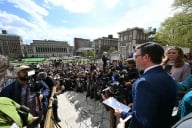You have /5 articles left.
Sign up for a free account or log in.
Worries about stock market turmoil subsided in the two days since Donald Trump unexpectedly won the presidential election, but many questions still remain about what Tuesday’s results mean for college and university finances.
Will markets turn ugly and imperil endowment returns if Trump proves unpredictable as president? Will proposed changes to the tax code help or hinder fund-raising? What effect could new economic and immigration policies have on the pool of tuition-paying students? And, critically, what will happen to federal funding for research and student financial aid?
Several experts zeroed in on that last question, pointing out that Trump promised substantial tax cuts during his campaign while also promising to protect Social Security and Medicare. With several other potentially big-ticket items proposed -- from a wall on the Mexican border to a major infrastructure-building package -- some believe federal funding for higher education could end up being cut.
“What is going to get cut is discretionary spending,” said John J. Cheslock, director of the Center for the Study of Higher Education and associate professor of education at Pennsylvania State University. “Where does higher education get its money? It gets its money from discretionary spending.”
Public postsecondary institutions across the country collectively received $51.3 billion in revenue from federal grants, contracts and appropriations in 2013-14, according to National Center for Education Statistics data. That was 14.5 percent of their total revenue that year. Private nonprofit postsecondary institutions received $23.7 billion in federal appropriations, grants and contracts, 10.3 percent of total revenue. Some of that grant revenue is from student aid -- Pell Grants are typically reported by public institutions as revenue from federal grants, but they are reported by private institutions as tuition and fees.
The federal government disburses about $130 billion in student aid every year, including federal direct loan, federal Pell Grants and federal work-study programs. Cutbacks in federal aid would place more pressure on colleges’ and universities’ other sources of funding, including state funding, tuition revenue, endowments and fund-raising.
“If the government spends less on them, that will have an impact,” Cheslock said. “The complete unknown of the economy then impacts tons of things.”
Yet there is still no confirmation that federal funding for higher education will be cut. And if it is, it’s not clear where those cuts would fall. Cheslock believes it’s more likely research grants will be cut than student aid, because students and their families represent more voters than do researchers. If that’s the case, research universities could be harder hit than other institutions.
If public funding from states is a question, it’s one that’s probably not tied to national elections. National politics are unlikely to have a direct effect on state appropriations to higher education, said George Pernsteiner, president of the State Higher Education Executive Officers association. Instead, states’ fiscal concerns will drive them.
“It will be, I think, as we have seen in the last few years, uneven across the country depending on local conditions,” Pernsteiner said.
College and university budgets are most heavily dependent on tuition and fee revenue, however. Trump talked about forcing colleges to cut their tuition rates while he was on the campaign trial. His anti-immigration rhetoric has also worried international students and caught the attention of the financial community.
Moody’s Investors Service focused on potential changes in government policies on immigration, student visas and poststudy work by international students in a report on Trump’s proposals. Immigration changes could immediately affect universities’ international enrollment, which has spiked by 73 percent in the last decade, Moody’s wrote.
“Loss of tuition revenue from international students, an important revenue diversifier for some universities, would be credit negative, particularly for universities with less well-known global brands and those that more recently entered the international student market,” according to Moody’s.
Experts, meanwhile, wondered what Trump’s economic proposals could do to tuition revenue.
If Trump’s policies like trade protectionism and infrastructure spending end up boosting middle-class families’ fortunes, it could mean a boom for enrollments as families attain a newfound ability to send students to college. Subsequently, that would likely boost college revenues. But if the income gap widens under Trump, or if student aid is cut substantially, enrollments could fall.
“Most schools are tuition driven,” said David Strauss, a principal at Baltimore-based strategy consulting firm Art & Science Group. “Enrollment revenues might change in a dramatic way.”
Those in fund-raising have raised several possible scenarios going forward, Strauss said. Trump’s proposed tax cuts could benefit wealthy donors, providing them with more money to give away to colleges and universities. Major gifts already tend to come from the wealthy.
But Strauss talked to one official in a college development office who worried that Republicans in Congress will slash the size of the federal government, pulling it back from some issues that motivate well-heeled donors. If, for example, the Environmental Protection Agency is gutted, some donors might give to environmental causes instead of universities.
“He is envisioning a potential for greater philanthropic competition as government pulls back from things,” Strauss said of the conversation with the development officer.
There does not appear to be any direct connection between the presidency and giving patterns, said Noah Drezner, an associate professor of higher education at Columbia University Teachers College. The state of the economy plays a major role in giving, though. Years with large market sell-offs often bring drops in giving.
“We see drops during and slightly after each recession,” Drezner said in an email. “Stock market volatility is an indicator of giving patterns, as most large gifts involve some portion of appreciated assets.”
Drezner agreed tax policy can play a role in donors’ actions. He pointed to the historical precedent of the 1986 tax cuts put in place under Ronald Reagan’s administration. Giving increased just before the cuts were put in place, and then it dropped off sharply afterward. He attributed the change to the tax cut effectively lowering the benefit of giving.
“People gave more when the benefit was higher and slowed their giving right after,” Drezner said.
There is also no clear relationship between elections and endowment returns. A look at National Association of College and University Business Officers data on median annual U.S. college and university endowment returns in the fiscal years that ended after the last six presidential elections showed only two years of negative returns. Those years were 2001 and 2009, when recessions that predated elections were underway.
Since the election, U.S. markets have done well, more than recovering from an initial plunge Tuesday night when it first became clear Trump was winning the presidency. The Chicago Board Options Exchange Volatility Index is down postelection. That comes after many endowment managers decided to hold firm to their strategies as Election Day approached.
The question for endowment managers now is one of adjusting to asset classes and stocks that could be impacted by the changes in Washington, said Michael H. Strauss, chief economist at asset management firm Commonfund.
“We haven’t seen massive changes from endowments,” he said. “You will probably see more of a focus toward equity exposure and away from traditional fixed-income exposure.”
Trump has talked about colleges and universities needing to spend money from their endowments, and some Republicans have proposed minimum spending requirements. But while that might have an impact on institutions’ ability to grow their endowments, it’s unlikely to significantly impact most college operating budgets.
“If they make institutions increase the spending rate, it all depends on how far they go,” said Rick Hesel, another principal at Art & Science. “For a lot of places, it doesn’t make a lot of difference in what it contributes to the operating expenses.”
The possibility also exists that Trump and the Republican Congress will seek to cut many of the regulations put in place under President Obama’s administration. Some believe that could cut institutions’ costs. Others worry that deregulation could lead to a return to the for-profit college industry, increasing competition for federal funding.
At the end of the day, it’s hard to tell what Trump will do, said Michelle Asha Cooper, president of the Institute for Higher Education Policy.
“During the election season, we have not been given much detail about his interest or platform for higher education,” she said. “It makes it very difficult to predict what the future might hold, not just in terms of institutional finance but in a number of areas.”
That left colleges and universities watching.
“All the institutions are likely to wait and see,” said Pernsteiner, the SHEEO president.








